Chapter 9: Maintaining and Troubleshooting
In This Chapter
 Taking care of your iPad
Taking care of your iPad
 Solving common iPad problems
Solving common iPad problems
 Finding technical support
Finding technical support
 Finding a missing iPad
Finding a missing iPad
 Backing up to iCloud
Backing up to iCloud
iPads don’t grow on trees — they cost a pretty penny. That’s why you should know how to take care of your iPad and troubleshoot any problems that it might have so you get the most out of it.
In this chapter, I provide some advice about the care and maintenance of your iPad, as well as tips about how to solve common problems, update iPad system software, and even reset iPad should something go seriously wrong. In case you lose your iPad, I even tell you about a feature that helps you find it — or even disable it if it’s fallen into the wrong hands. Finally, you get information about backing up your iPad settings and content using iCloud.
Maintaining Your iPad
You have a great gadget and an investment to protect in your iPad. A few simple precautions can keep it damage-free — at least until you rush out and buy the next version.
It’s wise to keep the screen clean and safe from damage, as well as maximize your battery use. The following sections tell you how.
Keeping the iPad screen clean
If you’ve been playing with your iPad, you know — despite Apple’s claim that iPads have fingerprint-resistant screens — that iPads are fingerprint magnets. They’re covered with an oil-resistant coating, but that definitely doesn’t mean they’re smudge-proof.
Here are some tips about cleaning your iPad screen:
 Use a dry, soft cloth. You can get most fingerprints off with a dry, soft cloth such as the one you use to clean your eyeglasses or a cleaning tissue that’s lint- and chemical-free. Or try products used to clean lenses in labs, such as Kimwipes or Kaydry, which you can get from several major retailers such as Amazon.
Use a dry, soft cloth. You can get most fingerprints off with a dry, soft cloth such as the one you use to clean your eyeglasses or a cleaning tissue that’s lint- and chemical-free. Or try products used to clean lenses in labs, such as Kimwipes or Kaydry, which you can get from several major retailers such as Amazon.
 Use a slightly moistened soft cloth. To get the surface even cleaner, slightly moisten the cloth before you use it to clean the screen. Again, make sure whatever cloth material you use is lint-free.
Use a slightly moistened soft cloth. To get the surface even cleaner, slightly moisten the cloth before you use it to clean the screen. Again, make sure whatever cloth material you use is lint-free.
 Remove the cables. This may go without saying, but I’ll say it anyway: If you don’t want a fried iPad, turn it off and unplug any cables from it before cleaning the screen with a moistened cloth.
Remove the cables. This may go without saying, but I’ll say it anyway: If you don’t want a fried iPad, turn it off and unplug any cables from it before cleaning the screen with a moistened cloth.
 Avoid too much moisture. Avoid getting too much moisture around the edges of the screen where it can seep into the unit.
Avoid too much moisture. Avoid getting too much moisture around the edges of the screen where it can seep into the unit.
 Never use any household cleaners on your iPad screen. They can degrade the coating that keeps the screen from absorbing oil from your fingers.
Never use any household cleaners on your iPad screen. They can degrade the coating that keeps the screen from absorbing oil from your fingers.
 Do not use premoistened lens-cleaning tissues to clean your screen. Most of these wipe products contain alcohol, which can damage the screen’s coating.
Do not use premoistened lens-cleaning tissues to clean your screen. Most of these wipe products contain alcohol, which can damage the screen’s coating.
Protecting your gadget with a case
Your screen isn’t the only element on the iPad that can be damaged, so consider getting a case for it so you can carry it around the house or around town safely. Besides providing a bit of padding if you drop the device, a case makes the iPad less slippery in your hands, offering a better grip when working with it.
Several types of cases are available, and more are showing up all the time. You can choose the Smart Cover from Apple, for example ($39 for polyurethane finish or $69 for leather), or covers from other manufacturers, such as Tuff-Luv (www.tuff-luv.com) and Griffin Technology (www.griffintechnology.com), that come in materials ranging from leather (see Figure 9-1) to silicone. (See Figure 9-2.)
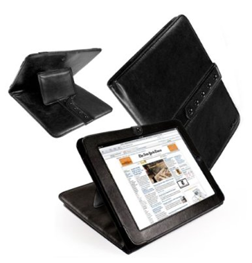
Figure 9-1: A lovely leather case, with a built-in stand mechanism for better viewing.
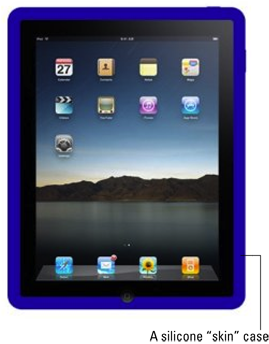
Figure 9-2: A less-expensive option is a silicon skin.
Cases range in price from a few dollars to $70 or more for leather; some will cost you hundreds of dollars. Some provide a cover (refer to Figure 9-1), and others protect only the back and sides or, in the case of Smart Cover, only the screen. (Refer to Figure 9-2.) If you carry around your iPad much at all, consider a case with a screen cover to provide better protection for the screen or use a screen overlay, such as the invisibleSHIELD from ZAGG (www.zagg.com).
Extending your iPad’s battery life
The much-touted, ten-hour battery life of the iPad is a wonderful feature, but you can take some steps to extend that battery life even further. You can estimate how much battery life you have left by looking at the Battery icon in the far-right end of the Status bar at the top of your screen. Here are a few tips to help that little icon stay full up:
 Use a wall outlet to charge. Though it can vary depending on your computer model, generally when connected to a Mac computer, iPad can slowly charge; however, some PC connections don’t provide enough power to prevent battery drain. Even so, the most effective way to charge your iPad is to plug it into the wall outlet using the Dock Connector to USB Cable and the 10W USB Power Adapter that came with your iPad. (See Figure 9-3.)
Use a wall outlet to charge. Though it can vary depending on your computer model, generally when connected to a Mac computer, iPad can slowly charge; however, some PC connections don’t provide enough power to prevent battery drain. Even so, the most effective way to charge your iPad is to plug it into the wall outlet using the Dock Connector to USB Cable and the 10W USB Power Adapter that came with your iPad. (See Figure 9-3.)

Figure 9-3: The provided cord and power adapter.
 Turn off the iPad. The fastest way to charge the iPad is to turn it off while charging it.
Turn off the iPad. The fastest way to charge the iPad is to turn it off while charging it.
 Avoid USB ports on keyboards. Your battery may lose some power if you leave it connected to the USB port on a keyboard or other device.
Avoid USB ports on keyboards. Your battery may lose some power if you leave it connected to the USB port on a keyboard or other device.
 The best way to charge your iPad is with the included cord plugged into an electrical outlet. Using your computer to charge it can take a great deal longer.
The best way to charge your iPad is with the included cord plugged into an electrical outlet. Using your computer to charge it can take a great deal longer.
 Limit the screen’s impact on the battery. Turn off the screen when not in use because the display eats up power. Also, reduce the screen brightness in Settings to save power.
Limit the screen’s impact on the battery. Turn off the screen when not in use because the display eats up power. Also, reduce the screen brightness in Settings to save power.
 Turn off Wi-Fi. If you’re not using Wi-Fi, turn it off under Settings. Constantly maintaining a Wi-Fi connection or searching for a signal can use up a bit of power.
Turn off Wi-Fi. If you’re not using Wi-Fi, turn it off under Settings. Constantly maintaining a Wi-Fi connection or searching for a signal can use up a bit of power.
Troubleshooting Your iPad
Though everyone wants to think that their iPads are perfect magical machines, unburdened with the vagaries of crashing Windows PCs and system software bugs, that’s not always the case.
Here are some common issues that can come up with iPad, and ways around them.
Dealing with a nonresponsive iPad
If your iPad goes dead on you, it’s most likely a power issue, so the first thing to do is to plug the Dock Connector to USB Cable into the 10W USB Power Adapter, plug the 10W USB Power Adapter into a wall outlet, plug the other end of the Dock Connector to USB Cable into your iPad, and charge the battery.
Another thing to try — especially if you think that an app might be hanging up the iPad — is to press the Sleep/Wake button for a few seconds. Then, press and hold the Home button. The app you were using should close.
You can always try the old reboot procedure, which in the case of an iPad means pressing the Sleep/Wake button on the top until the red slider displays. Drag the slider to the right to turn off your iPad. After a few moments, press the Sleep/Wake button to boot up the little guy again. Be sure your battery has a decent charge because this procedure can eat up battery power.
If the situation seems drastic and none of these ideas works, try to reset your iPad. To do this, press the Sleep/Wake button and the Home button at the same time until the Apple logo appears onscreen.
Updating software
Just as software manufacturers provide updates for your main computer, Apple occasionally updates the iPad system software to fix problems or offer enhanced features. If you’re not using the iCloud feature, which updates your iOS automatically, occasionally check for an updated version (say, every month).
If you choose not to use iCloud, follow these steps to update the iPad system software using a connection to your computer:
1. Connect your iPad to your computer.
2. On your computer, open the iTunes software you installed.
(See Book I, Chapter 4 for more about this topic.)
3. Click your iPad’s name in the iTunes Source List on the left.
4. Click the Summary tab, as shown in Figure 9-4.
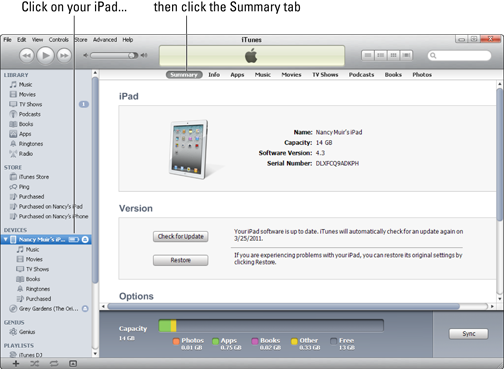
Figure 9-4: Get system updates for iPad through your iTunes account.
5. Click the Check for Update button.
iTunes displays a message telling you whether a new update is available.
6. Click the Update button to install the newest version.
Restoring sound
Coincidentally, the very morning I wrote this chapter, my husband was puttering with his iPad. Suddenly, the sound stopped. We gave ourselves a quick course in recovering sound, so now I can share these tips with you. Make sure that
 You haven’t touched the volume control keys on a physical keyboard connected to your iPad via Bluetooth. They’re on the right side of the top-right side of your iPad when holding it in portrait orientation. Be sure not to touch one and inadvertently lower the sound ’til it’s essentially muted.
You haven’t touched the volume control keys on a physical keyboard connected to your iPad via Bluetooth. They’re on the right side of the top-right side of your iPad when holding it in portrait orientation. Be sure not to touch one and inadvertently lower the sound ’til it’s essentially muted.
 You haven’t flipped the Silent switch. If you have the Screen Rotation/Silent switch set to control sound, moving the switch mutes sound on your iPad.
You haven’t flipped the Silent switch. If you have the Screen Rotation/Silent switch set to control sound, moving the switch mutes sound on your iPad.
 The speaker isn’t covered up. Make sure you haven’t covered up the speaker in a way that muffles the sound.
The speaker isn’t covered up. Make sure you haven’t covered up the speaker in a way that muffles the sound.
 A headset isn’t plugged in. Sound won’t play through the speaker and the headset at the same time.
A headset isn’t plugged in. Sound won’t play through the speaker and the headset at the same time.
 The Volume Limit is set to Off. You can set up the Volume Limit in Music Settings to control how loudly the Music app can play (which is useful if your partner’s into loud Rap music). Tap the Settings icon on the Home screen, and then on the left side of the screen that displays, tap Music and use the Volume Limit controls (see Figure 9-5) to turn down the Volume Limit.
The Volume Limit is set to Off. You can set up the Volume Limit in Music Settings to control how loudly the Music app can play (which is useful if your partner’s into loud Rap music). Tap the Settings icon on the Home screen, and then on the left side of the screen that displays, tap Music and use the Volume Limit controls (see Figure 9-5) to turn down the Volume Limit.
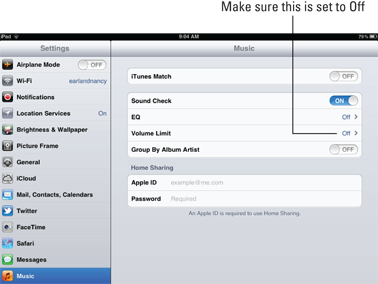
Figure 9-5: Volume Limit lets your iPad get only so loud.
Getting Support
As you may already know if you own another Apple device, Apple is known for its great customer support, so if you’re stuck, I definitely recommend that you try them out. Here are a few options you can explore for getting help:
 The Apple Store: Go to your local Apple Store if one is handy to find out what the folks there might know about your problem.
The Apple Store: Go to your local Apple Store if one is handy to find out what the folks there might know about your problem.
 The Apple iPad Support website: Visit this site at
The Apple iPad Support website: Visit this site at www.apple.com/support/ipad. (See Figure 9-6.) Here you find online manuals, discussion forums, downloads, and the Apple Expert feature, which enables you to contact a live support person by phone.
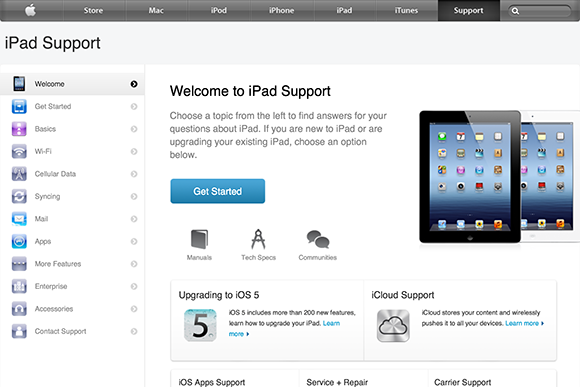
Figure 9-6: Don’t forget to check out the manuals and discussions for help.
 The iPad User Guide: You can use the bookmarked manual on the Safari browser or visit
The iPad User Guide: You can use the bookmarked manual on the Safari browser or visit http://manuals.info.apple.com/en_us/ipad_user_guide.pdf. This is a more robust version of the bookmarked User Guide. You can also download the manual and read it in most popular e-reader programs.
 The Apple battery replacement service: If you need repair or service for your battery, visit
The Apple battery replacement service: If you need repair or service for your battery, visit www.apple.com/batteries/replacements.html.
Finally, here are a few useful non-Apple discussion forums that may help provide some answers:
 MacRumors at
MacRumors at http://forums.macrumors.com/forumdisplay.php?f=137
 The iPad Guide discussions at
The iPad Guide discussions at www.theipadguide.com/forum
 ipad.org provides several useful threads at
ipad.org provides several useful threads at http://ipad.org/forum
Finding a Missing iPad
You can take advantage of the Find My iPad feature to pinpoint the location of your iPad. This is a very handy feature if you forget where you left your iPad or somebody walks away with it. Find My iPad not only lets you track down the critter, but also lets you wipe off the data contained in it if you have no way to get the iPad back.
Follow these steps to set up this feature:
1. Tap the Settings icon on the Home screen.
2. In the Settings pane, tap iCloud.
3. In the iCloud settings that appear, tap the On/Off button for Find My iPad to turn on the feature (see Figure 9-7).
4. From now on, if your iPad is lost or stolen, go to http://iCloud.com and enter your ID and password.
The Find My iPad screen appears with your iPad’s location noted on a map.
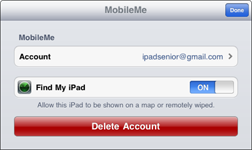
Figure 9-7: Turn the feature on or off to locate your iPad from your computer.
 Additionally, if you feel like your iPad is in the hands of someone who might misuse the data on it, you can use this feature to lock the device and even delete all data you’ve added to your iPad manually or by syncing. Just know, though, that the latter isn’t reversible. To wipe information from the iPad, click the Remote Wipe button. (See Figure 9-8.) To lock the iPad from access by others, click the Remote Lock button. Remember that this will erase all content, such as contacts, music, notes, and so on for good.
Additionally, if you feel like your iPad is in the hands of someone who might misuse the data on it, you can use this feature to lock the device and even delete all data you’ve added to your iPad manually or by syncing. Just know, though, that the latter isn’t reversible. To wipe information from the iPad, click the Remote Wipe button. (See Figure 9-8.) To lock the iPad from access by others, click the Remote Lock button. Remember that this will erase all content, such as contacts, music, notes, and so on for good.

Figure 9-8: To protect data on your iPad, as a last resort you can wipe it clean.
Backing Up to iCloud
To perform a backup to iCloud:
1. Set up an iCloud account and then tap Settings on the Home screen.
See Book I, Chapter 5 for details on creating an iCloud account.
2. Tap iCloud and then tap Storage & Backup (see Figure 9-9).
3. In the pane that appears (see Figure 9-10), tap the iCloud Backup On/Off switch to enable automatic backups, or to perform a manual backup, tap Back Up Now.
A progress bar shows how your backup is moving along.
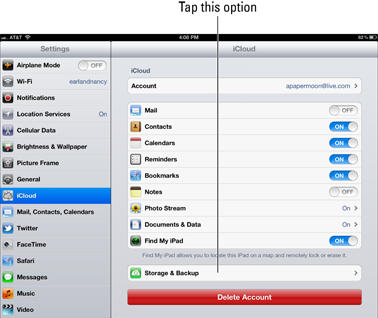
Figure 9-9: Backing up to the cloud.
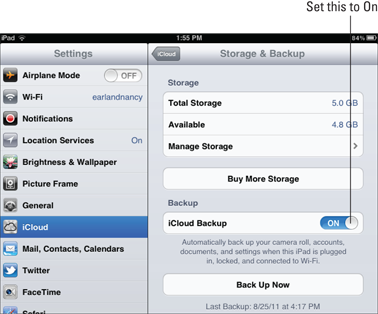
Figure 9-10: Automatic backups ensure your data is saved.
 You used to be able to back up your iPad content using only iTunes, but with Apple’s introduction of iCloud, you can back up via a Wi-Fi network to your iCloud storage. You get 5GB of storage (not including iTunes-bought music, videos, apps, and electronic books or content pushed automatically among your Apple devices by iTunes Match) for free, or you can pay for increased levels of storage (10GB for $20 per year, 20GB for $40 per year, or 50GB for $100 per year).
You used to be able to back up your iPad content using only iTunes, but with Apple’s introduction of iCloud, you can back up via a Wi-Fi network to your iCloud storage. You get 5GB of storage (not including iTunes-bought music, videos, apps, and electronic books or content pushed automatically among your Apple devices by iTunes Match) for free, or you can pay for increased levels of storage (10GB for $20 per year, 20GB for $40 per year, or 50GB for $100 per year).